Bearded dragons drink water from droplets easily, but not so much from a bowl of water. Bearded dragons are attracted to droplets of water on plants (Johnson et al, 2018) and even dripping off the walls or accessories. Offering a bearded dragon a water bowl in its tank, is not enough to get it to drink. Drinking from bowls is not natural for bearded dragons and they are best misted (Boyer, 2015) or spray items in the enclosure for them to drink the drips.
When a bearded dragon is dehydrated, even mildly on a continuous basis, health problems will follow. Health issues caused by dehydration include gout, shedding issues (dysecdysis) (Stahl and Donoghue 2010), kidney disease and constipation.
Continual mild dehydration, including during long or poorly managed brumation, can result in or contribute to, significant health issues and (in extreme cases) death. For help to safely brumate your bearded dragon see the post on brumation.
Jump To…
What Others in the Community saw their Bearded Dragons Doing
Did you think it was just your bearded dragon that won’t drink? At Bearded Dragons World we conducted a survey with community members to see what others were experiencing, specifically:
- if their bearded dragon won’t drink, or
- their bearded dragons drink water and if so,
- how often their bearded dragon is drinking.
Here is what they said. Out of a total of 73 bearded dragons it was found that 66% of bearded dragons had a water bowl in their tank, provided continual access to water.
Out of those:
7% of the bearded dragons were seen drinking on multiple occasions.
31% were seen to drink occasionally (less than once a week).
54% had never seen their bearded dragon drinking directly from the water bowl.
8% of bearded dragons won’t drink unless assisted.
Signs your Bearded Dragon is Dehydrated
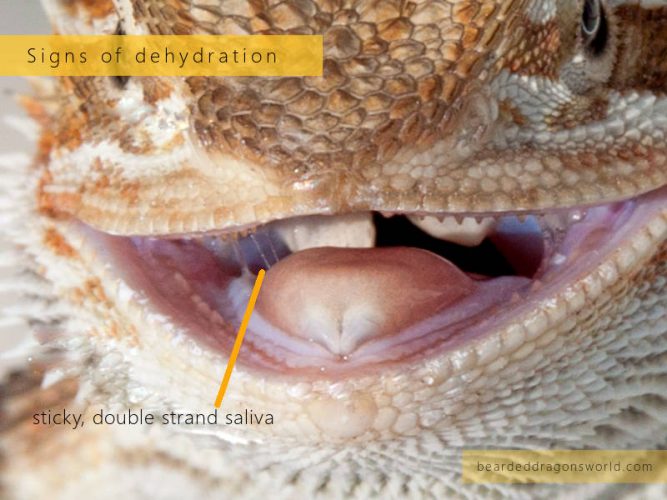
If your bearded dragon isn’t being given water, chances are it is dehydrated. Signs of dehydration include:
- wrinkled skin
- the saliva tackiness, double strands forming when the mouth opens.
- decreased elasticity in the skin, the skin tents when gently pinched.
- sunken eyes (Gibbons, 2009)
To perform the pinch test, gently pinch a bit of soft skin and see how long it takes to bounce back. If the skin is slow to bounce back then dehydration is likely. Their skin isn’t as elastic as ours.
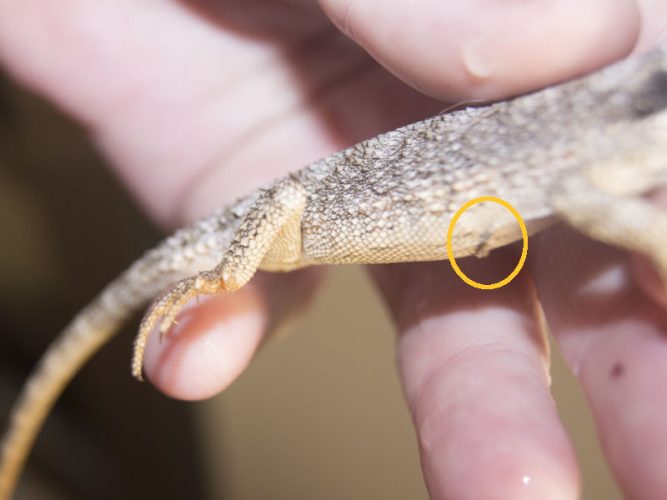
The Veterinary Nursing of Exotic Pets by Simon Girling states that by the time the reptile gets to 3% the urates will be reduced and it might be a little lethargic. At 10% dehydration it will be “dull to comatose”.
No one is going to notice a 3% difference in urates, so do not rely on that as a means to identify dehydration.
As dehydration progresses it will become a little more obvious with the skin on its back wrinkling. There are other possible causes for wrinkling which includes just having room for growth but it is easy enough to tell the difference.
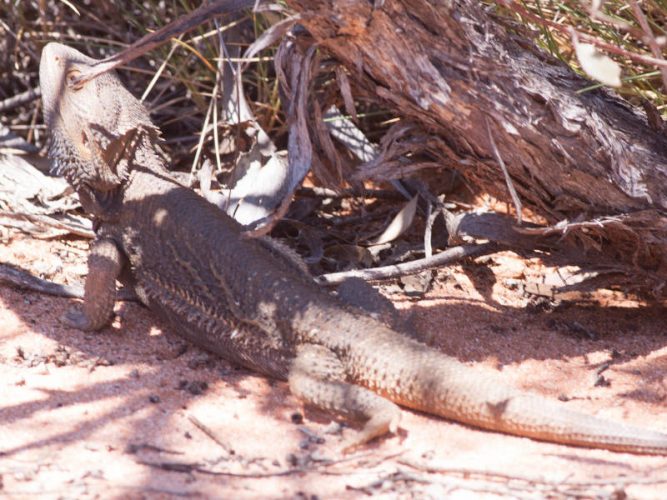
Bowel movements have probably become a little less frequent moving on towards constipation (such a common cause of constipation and so easy to avoid). Shedding may be slowing down or becoming problematic.
The mucous membranes will get a bit tacky, again to what extent will be dependent on the degree of dehydration.
As the level continues to increase, signs may include sunken eyes, muscle weakness or even gout. Behavioral signs may include decreased body weight and reduced activity. This is really serious by the time these signs occur and radical changes need to happen immediately including adding a vet to the mix.
Can Bearded Dragons have Tap Water?
Bearded dragons can have tap water. Divers and Mader (2015) state that hard water is safe for reptiles. Soft water has sodium which should only present an issue if sodium must be restricted for a medical reason.
Reptiles do not need demineralized or distilled water (Divers and Mader, 2015).
Bearded dragons can drink and bath in tap water. Divers and Mader (2015) recommend using the guidelines from the World Health Organisation for water quality guidelines until further information is available specific to reptiles.
5 Fail-Proof Ways to Get Your Bearded Dragon to Drink
Here are 5 easy and fail-proof ways to get your bearded dragon to drink water and stay hydrated. Combine these ways to hydrate your bearded dragon for best results.
1. Spraying Your Bearded Dragon
Do Bearded Dragons Need Misting? If your bearded dragon won’t drink try misting surfaces it can lick.
A bearded dragon does not need misting. If the humidity is too low or is it is having difficulty in shedding, then it can be useful. However, whether bearded dragons need misting is not really an issue, its more about providing them water that they can learn to drink and it can be fun.
Some enjoy sliding on misted surfaces and can’t help but give it a lick on its way through. Moving water droplets is much more attractive than bowls of water.

The surfaces to be misted should be clean prior to wetting, which makes it a practice best done after the daily cleaning.
Wetting the floor surface can encourage ‘surfing’ which is quite amusing to watch. This is where their body flattens on the floor with their their belly sliding along the surface and perhaps having a lick along the way.
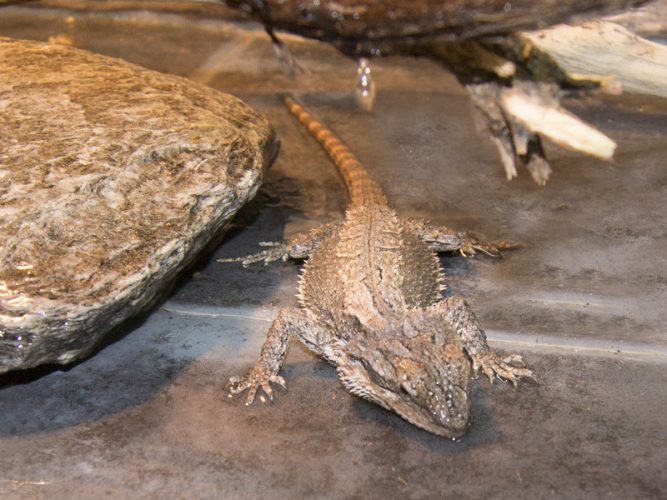
Clearly you can’t mist bearded dragons cage floor if it has loose substrate. Good reason to change to something more versatile like tiles if you haven’t already. More on the best substrates for bearded dragons here.
Clean up the water after misting especially in glass tanks or other enclosures with poor air circulation. Mist outside of the habitat if it is a problem that cannot be fixed.
Bearded Dragons World Community Survey Discovers Who Else is Spraying their Bearded Dragon
A small group of the community were asked how often do they spray (mist) their bearded dragons.
57% mist their bearded dragons ranging between daily to once a week.
14% of bearded dragons were misted occasionally if the weather was hot.
42% of bearded dragons were not sprayed at all.
The majority of respondents in this survey kept their bearded dragons glass tanks which is likely to provide some explanation for the lack of misting routines.
2. Bearded Dragons Need a Water Bowl
Bearded dragons need a water bowl to be shallow and kept clean. Even if your bearded dragon doesn’t drink from the water bowl or dish, it is likely that it will just lay or stand in it at times. This provides some environmental stimulation that it wouldn’t otherwise have.
If the humidity is too high in the enclosure then just leave the water bowl for a fixed time and remove it. Excessive humidity problems are often an issue with glass tanks. Wood and other materials which are easy to install additional venting on are far better for bearded dragons. For more information on humidity see the post Complete Guide to Humidity for Bearded Dragons.
Keep the water on the cool side of the housing. Warm stagnant water in the habitat is a breeding ground for pathogens and some parasites. However, if kept clean, this can add to the environmental enrichment. Issues really occur with poor husbandry practices or enclosures that are too small or inadequate like glass tanks.
Bearded dragons can dehydrate even with the a water bowl in front of them. They do not seem to instinctively know to drink from a bowl of still water.
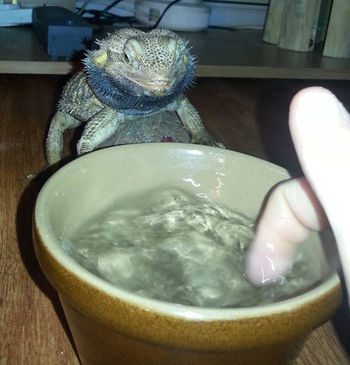
Water that shows some signs of movement, even a drip hitting the water surface, is far more attractive to bearded dragons than still water. To get your bearded dragon to drink water try making the water move and perhaps putting a droplet of water on its snout. You could also try squirting a water sprayer directly into the bowl. It may take hours, days or weeks to encourage your bearded dragon to drink from a bowl, some may never do it.
Some will enjoy walking through or laying in their water. Bearded dragons do tend to feel the urge to poop when in contact with water. Expect that some poop may be left in the water dish. Albeit not what we might prefer, it is still a valid use of the water, just additional cleaning is required.
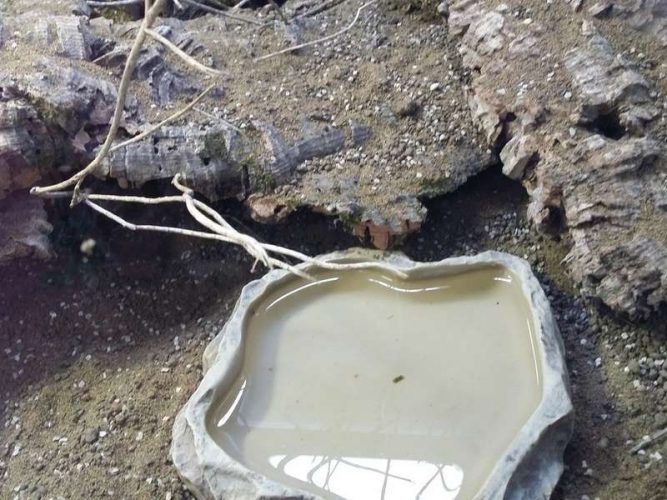
How To Teach Bearded Dragons to Drink Water
Here are some tips and tricks to teach bearded dragons to drink water.
Since moving water seems to attract bearded dragons when they are thirsty, moving from misting to drinking can be quite easy. Spray water on an something in the bearded dragons tank that will drip over into a water bowl and see if that brings any interest.
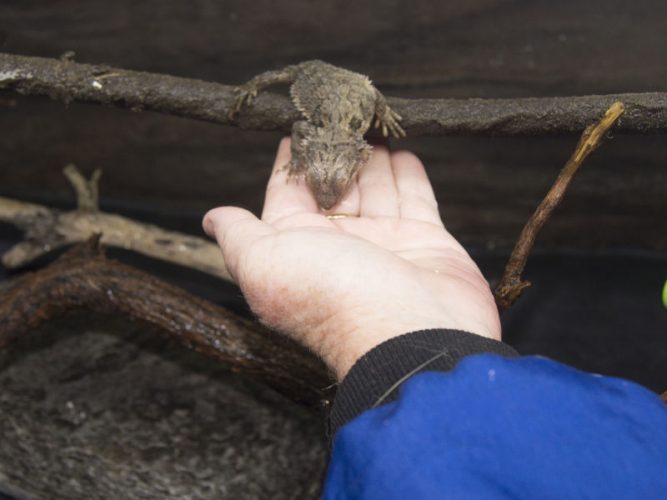
You could also try spraying water in your hand (cleaned of course). Trick is to let them see you actually spray the water. This may take a number of attempts and it will work better when they are thirsty, not much point doing it after bathing if they are resistant.
3. Bathing Bearded Dragons
Bathing is a popular way to hydrate bearded dragons. Some bearded dragons enjoy bathing and others become quite distressed about it.
Bathing on its own is unlikely to be enough to ensure your bearded dragon is hydrated. However, bearded dragons drink water in the bath as well. It only needs a few mils in a day. More on do bearded dragons need baths here.
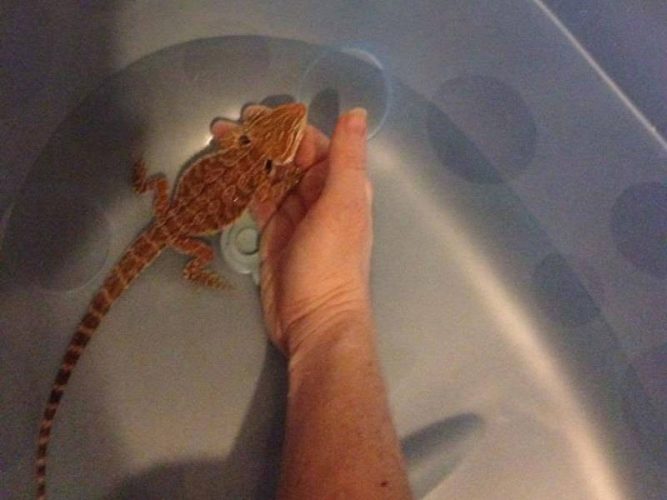
4. Bearded Dragons Drinking…what about Food?
Foods provide fluids and while they are not enough on their own, it is easy to increase. Misting bearded dragon food will add to the natural level of fluids in the food and together, likely provide sufficient water. This is a gentle and non intrusive way to hydrate your bearded dragon.
11 Foods With High water content
Although bearded dragons drink water, some also comes from food. Here are 11 foods that have a high water content that bearded dragons can eat.
| Food | Water_(g) |
| Watercress fresh, raw | 95.11 |
| Zucchini inc skin, raw | 94.79 |
| Lettuce Romaine or Cos fresh | 94.61 |
| Endive | 93.79 |
| Capsicum, bell peppers, raw | 93.3 |
| Mustard greens, frozen unprepared | 93.21 |
| Turnip greens, frozen | 92.93 |
| Cabbage, raw | 92.18 |
| Strawberry, raw | 92.1 |
| Rocket fresh raw | 91.8 |
| Watermelon, peeled | 91.6 |
References for data (national food databases and research) see the post Food & Nutrition for Bearded Dragons.
5 Syringe or Eye Dropper Makes a Super Useful Mini Hand Waterer!
Getting baby bearded dragons to drink water from a syringe is very easy and leaves less water around to clean up than misting or spraying. Baby bearded dragons drink water easily from a syringe in Soncysun’s video.
How much Water a Day do Bearded Dragons Drink?
The amount of water reptiles need per day for maintenance is 10-30 ml per kilo per day (Mitchell, 2008) based on ideal weight for the animal. The water content of foods is included.
A full sized adult Pogona vitticeps will weigh somewhere around 300 grams give or take. If the bearded dragon is dehydrated, skinny, obese, gravid or otherwise of abnormal size, then estimate the weight it should be under normal circumstances.
At the rate of 10-30 ml per kilo per day the average amount of water a bearded dragon would need a day would be something aroundabout 2 teaspoons worth of fluids (5ml per teaspoon). Minus water content of foods the actual volume of water to be taken by mouth in addition to food is reduced.
No age is exempt from needing additional water on top of food. Baby or hatchling bearded dragons drink water, as do juveniles and adults.
Conclusion
Bearded dragons drink water, need water and continual mild dehydration causes long term health issues. When a bearded dragon is dehydrated, it is also likely constipated. Provide water by a combination of hydrating routines including bathing, misting (spraying), food, drinking from a bowl and syringe or eye dropper.
Do bearded dragons need a water bowl?
Bearded dragons do not need a water bowl but being provided water ad lib offer a lot of benefits if kept clean. However, offering a bearded dragon water in a bowl, is not enough to get it to drink. A bearded dragon can dehydrate despite having a bowl of water at its disposal.
Should I mist my bearded dragon?
Bearded dragons can be misted and some will enjoy it immensely. Factors need to be considered before misting include the cleanliness of the environment and how easy it is to clean up residual water. Misting is useful for teaching bearded dragons to drink.
Do I need to give my bearded dragon water?
Bearded dragons need to be given water by mouth and will not be able to survive in good health with only water sourced from food.
References
- Boyer, T. H. (2015). How to Feed Reptiles Right.
- Divers, S. J. & Mader, D. R. (2015) Reptile Medicine and Surgery – E-Book 2nd Edition. Elsevier Health Sciences
- Girling, S. (2003) Veterinary nursing of exotic pets. Oxford, United Kingdom: Blackwell.
- Johnson, R., & Adwick, S. (2018). Central Bearded Dragons (Pogona vitticeps). Companion Animal Care and Welfare, 395–411.
- Stahl, S. & Donoghue, S. (2010) Nutrition of Reptiles. In: Hand MS, Thatcher CD, Remillard RL, et al, editors. Small Animal Clinical Nutrition. Topeka (KS): Mark Morris Institute.
- Mitchell, M. (DVM) (2008) Fluid therapy for reptiles (Proceedings). CVC in Kansas City Proceedings. DVM 360. http://veterinarycalendar.dvm360.com/fluid-therapy-reptiles-proceedings
- Gibbons, P. (Sept, 2009) Critical Care Nutrition and Fluid Therapy in Reptiles. Proceedings of the 15th Annual International Veterinary Emergency & Critical Care Symposium. Chicago, Illinois. 9(13): 91-94.
Is your bearded dragon drinking water with or without your help? Share your hydrating routine with us!


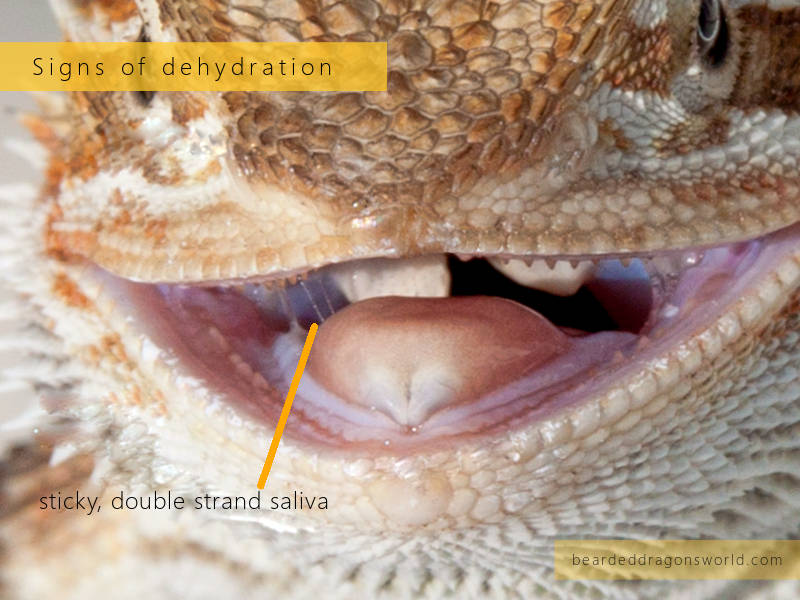

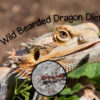


I spray his worms and greens with water and that seems to help.
Great idea. Maybe hold the water from insects on the days you are dusting the insects with supplements but I expect you are already doing that.
I have seen my beardie go under water and then stick his tongue out and out it back in his mouth. it looks like he is drinking do you think he is? I also am wondering some more tips on how to make his tank less humid. Thanks!
Yes it is possible that he is drinking. Here is the link to the information on humidity.
I like Deana idea. I’m going to try the worm idea.
Our guy enjoys bathing so we give him a bath about 3x a week. I’ve gotten him to drink water in the bath a few times by gently tapping the water to make small waves and splash a little. I think he’s been seen taking a quick lick of the water in his tank once. We’ll try misting his food, thank you for the advice.
Sounds perfect.
I drop his worms in his water dish so he can get water
@Deana, Thats very smart i will try to do that. Thaank you!